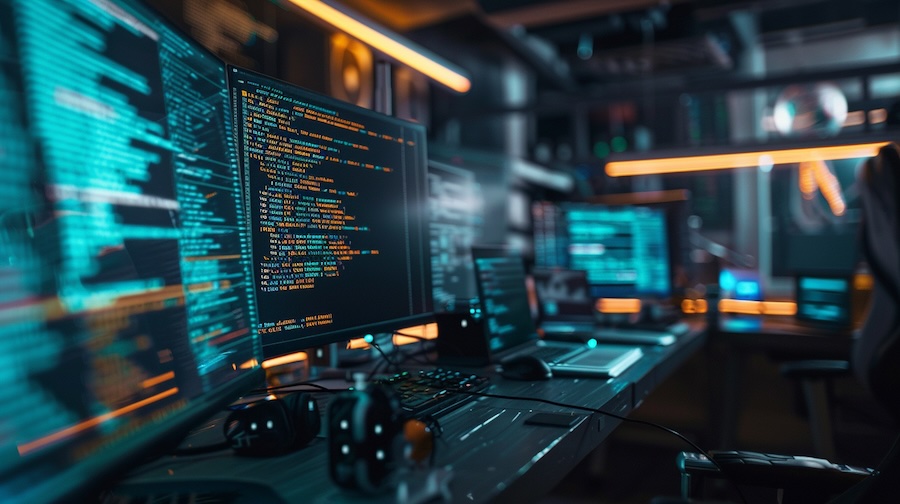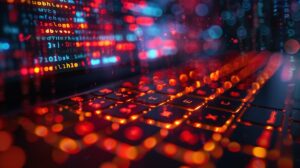We have created the “IoT Technology Trends: The Future of Connectivity.” blog post for the EU-Funded Code For Future Project (reference number: 2022-3-DE04-KA210-YOU-000092666).
Xient GmbH coordinates the project with L4Y Learning for Youth GmbH and Seyhan Danisment Gazi Anadolu Lisesi.
During this project, we will share more content regarding coding, which you can check through this link.
The Internet of Things: A Symphony of Connected Devices
The digital age has ushered in an era of unprecedented connectivity. No longer confined to computers and smartphones, the internet is weaving its way into the fabric of our physical world, giving rise to the Internet of Things (IoT). This intricate network encompasses a vast array of everyday objects embedded with sensors, processors, and software, enabling them to collect and exchange data. From smart thermostats optimizing energy usage to connected wearables monitoring our health, the IoT is revolutionizing the way we live, work, and interact with our surroundings.
Unveiling the Symphony: IoT Applications and Use Cases
The potential applications of the IoT are as vast and diverse as the devices themselves. Let’s delve into some of the most prominent use cases across various domains:
Smart Homes
Imagine a home that anticipates your needs. Smart thermostats learn your temperature preferences and adjust automatically, while connected lights illuminate rooms as you enter. Smart appliances can notify you when they require maintenance or reorder groceries when supplies dwindle. These interconnected devices create a personalized and convenient living environment.
Smart Cities
The IoT transforms urban landscapes into intelligent ecosystems. Traffic lights dynamically adjust based on real-time congestion data, optimizing traffic flow. Smart meters monitor energy consumption in buildings, enabling efficient resource management. Sensor networks track environmental conditions, allowing authorities to proactively address pollution or flooding risks.
Wearable Technology
Fitness trackers monitoring heart rate and activity levels are just the tip of the iceberg. Smartwatches can now track sleep patterns, provide contactless payments, and even display real-time health data for medical monitoring purposes. Wearable technology empowers individuals to take a more proactive approach to their health and well-being.
Industrial IoT (IIoT)
Factories of the future are abuzz with interconnected machines. Sensors monitor equipment performance, predicting potential breakdowns and enabling preventative maintenance. Connected robots collaborate seamlessly with humans, streamlining production processes and enhancing efficiency. The IIoT empowers industries to optimize operations, reduce costs, and ensure safety.
Connected Agriculture
Precision agriculture leverages the power of the IoT to optimize crop yields and resource utilization. Sensors monitor soil moisture, enabling targeted irrigation practices. Drones equipped with cameras can analyze crop health and detect potential infestations, allowing farmers to take timely action. The IoT paves the way for sustainable and efficient agricultural practices.
Beyond these examples, the potential applications of the IoT continue to expand, impacting sectors like healthcare, logistics, retail, and environmental monitoring.
The Underlying Harmony: Challenges and Considerations in IoT
While the potential of the IoT is undeniable, challenges and considerations must be addressed to ensure its smooth and secure operation.
Interoperability
The sheer variety of devices and protocols within the IoT ecosystem can create challenges in communication and data exchange. Standardization efforts are underway to ensure seamless interoperability between devices from different manufacturers.
Security Vulnerabilities
With so many connected devices, the attack surface expands significantly. Securing these devices and the data they collect is paramount. Robust security protocols, encryption techniques, and regular software updates are crucial to safeguard the integrity and privacy of data within the IoT.
Privacy Concerns
The vast amount of data collected by IoT devices raises privacy concerns. Clear data ownership policies, user consent mechanisms, and robust anonymization techniques are essential to ensure user data is protected and utilized responsibly.
Energy Consumption
The constant data transmission and processing within the IoT can lead to increased energy consumption. Developing energy-efficient devices and protocols is crucial for ensuring the sustainability of large-scale IoT deployments.
Network Bandwidth
The surge in connected devices places a strain on existing network infrastructure. The development of high-bandwidth, low-latency connectivity solutions like 5G is necessary to accommodate the demands of the IoT.
By addressing these challenges and prioritizing security, interoperability, and responsible data practices, we can unlock the full potential of the IoT and create a truly connected and intelligent world.
The Future Symphony: What Lies Ahead for the IoT
The future of the IoT promises exciting advancements and a more interconnected world:
Artificial Intelligence (AI) and Machine Learning (ML)
Integration of AI and ML into IoT devices will enable them to analyze data in real-time, automate tasks, and make intelligent decisions, further enhancing efficiency and personalization.
Edge Computing
Processing data closer to its source, at the “edge” of the network, will reduce latency and minimize reliance on centralized cloud resources, enabling faster decision-making and improved responsiveness within the IoT.
Blockchain Technology
Blockchain’s inherent security and transparency can be harnessed to secure data exchange within the IoT, providing a tamper-proof and auditable chain of custody for sensitive data.
Convergence with Emerging Technologies
The merging of the IoT with other emerging technologies like virtual reality (VR) and augmented reality (AR) will create immersive and interactive experiences, transforming the way we interact with the physical world. Imagine receiving real-time maintenance instructions overlaid on machinery through AR glasses while wearing VR equipment for remote collaboration with colleagues.
The Rise of Low-Power Wide-Area Networks (LPWAN)
LPWAN technologies offer extended range and low power consumption, making them ideal for connecting battery-powered devices over vast areas. This will facilitate the deployment of large-scale IoT networks in remote locations, enabling applications like environmental monitoring in forests or asset tracking across vast distances.
Focus on User Experience (UX)
As the IoT matures, user experience will take center stage. Devices will become more intuitive and user-friendly, with seamless integration into existing workflows and minimal disruption to daily routines. User-centric design principles will be paramount in ensuring widespread adoption and user satisfaction.
The Road Ahead: Building a Secure and Sustainable IoT Future
The journey towards a fully realized IoT future necessitates a collaborative effort. Here are some key considerations:
Standardization
Industry-wide collaboration and adoption of common standards are crucial for ensuring interoperability, scalability, and security within the IoT ecosystem.
Security by Design
Security considerations should be integrated into the design and development of IoT devices from the outset. Robust encryption protocols, regular security updates, and secure coding practices are essential to safeguard user privacy and data integrity.
Consumer Education
Raising awareness among consumers about data privacy and security risks associated with the IoT is crucial. Empowering users to make informed choices about the data they share and the devices they connect is essential for fostering trust and responsible adoption of the technology.
Ethical Considerations
As the IoT continues to evolve, ethical considerations must be addressed. Issues like data ownership, algorithmic bias, and potential misuse of data for surveillance purposes require careful examination and the development of ethical frameworks to govern the responsible deployment of the IoT.
By embracing these considerations and fostering a collaborative approach, we can navigate the challenges and unlock the immense potential of the IoT. The future holds immense promise for a world where interconnected devices work seamlessly together to improve our lives, optimize processes, and create a more sustainable and intelligent future.
IoT Technology Trends: References
- Ray, B. (2020). “Understanding the Internet of Things (IoT): Definition, Applications, and More.” Retrieved from https://www.analyticsvidhya.com/blog/2020/09/understanding-internet-of-things-iot/
- Zeadally, S., Siddiqui, F., Baig, Z., & Ikram, A. (2020). “Internet of Things (IoT) security: Current status, challenges and prospective measures.” Retrieved from https://link.springer.com/article/10.1007/s11276-020-02439-8
- Gartner. (2020). “Gartner Top 10 Strategic Technology Trends for 2020.” Retrieved from https://www.gartner.com/smarterwithgartner/gartner-top-10-strategic-technology-trends-for-2020/
- Statista. (2020). “Internet of Things (IoT) connected devices installed base worldwide from 2015 to 2025 (in billions).” Retrieved from https://www.statista.com/statistics/471264/iot-number-of-connected-devices-worldwide/
- Deloitte. (2019). “IoT in the smart home: A market snapshot.” Retrieved from https://www2.deloitte.com/content/dam/Deloitte/us/Documents/consumer-business/us-consumer-iot-in-the-smart-home.pdf
IoT Technology Trends: Conclusion
The journey into the Internet of Things (IoT) realm transforms the ordinary into the extraordinary. However, at every step of this transformation, it is crucial not to overlook fundamental elements such as security, interoperability, and user experience. By considering our ethical responsibilities alongside technological advancements, we can maximize the potential offered by the IoT.
Security serves as the cornerstone of IoT. Data privacy and cybersecurity are the foundation of the IoT ecosystem. Interoperability ensures seamless communication between different devices, enhancing the efficiency and effectiveness of IoT. User experience determines how technology interacts with people. User-centered design and personalized services enhance the impact of IoT in daily life.
In the future, in the interactive world of IoT, the security and privacy of users will be paramount, ensuring that the benefits of technology reach all communities fairly and equitably. With a responsible approach, the symphony of IoT will guide us toward a future that enhances human life and leaves behind a sustainable world for future generations.
Please follow our YouTube Channel.





